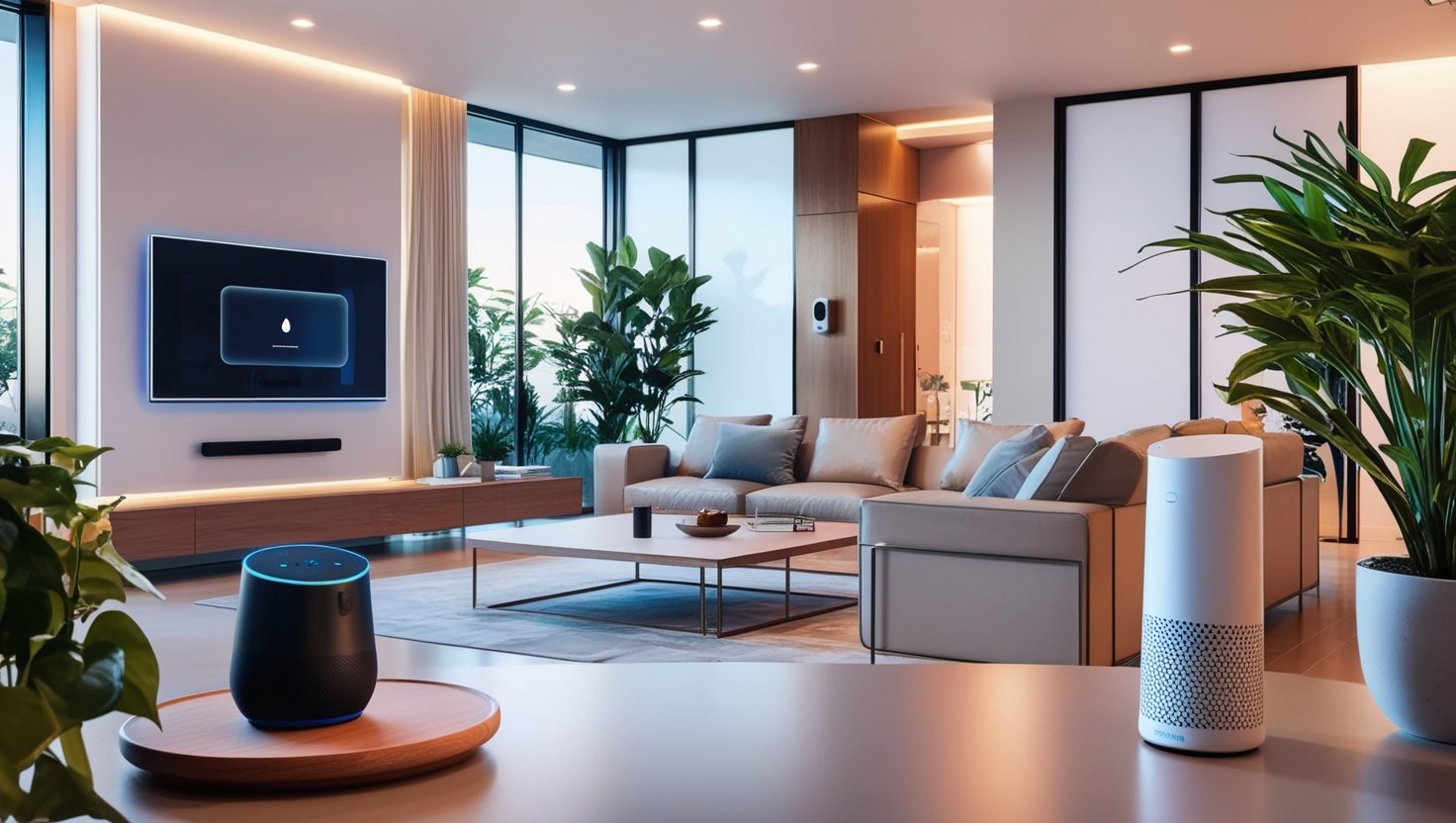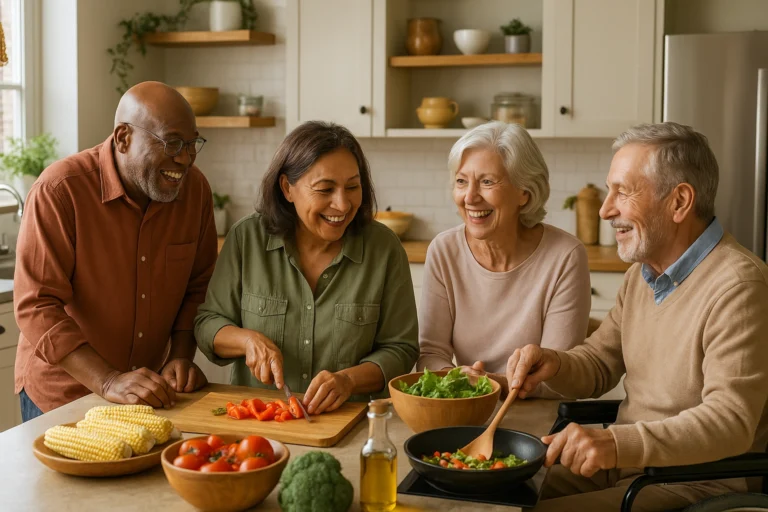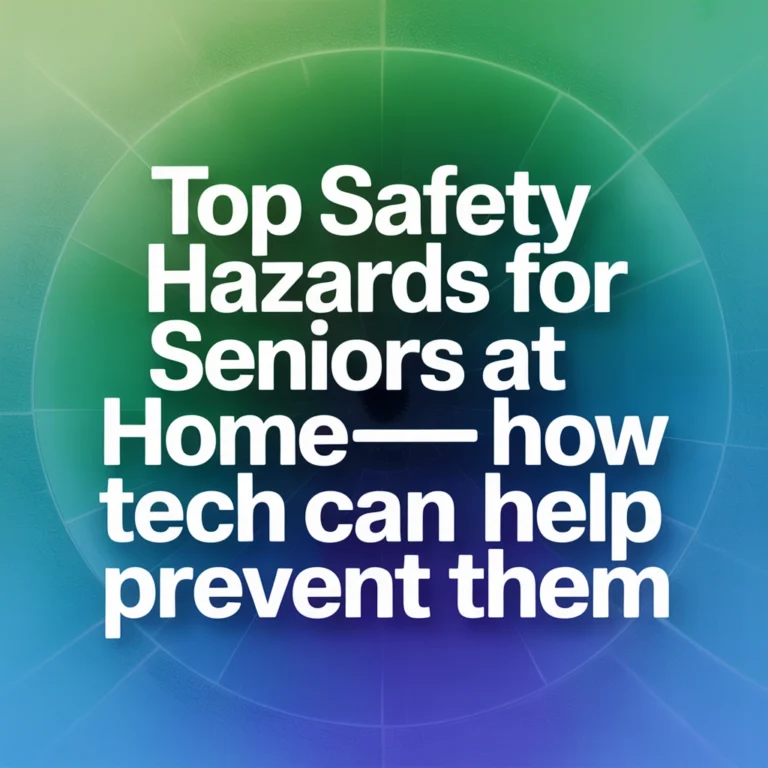Creating a safe home is so important for seniors. As we age, our bodies change, and even simple tasks can become a bit harder. A secure living space helps reduce the risk of falls and injuries, while also giving peace of mind to seniors and their families. At SeniorThrive, we know how vital it is to create a home that’s both safe and comfortable for aging loved ones.
In this article, we’re sharing seven unique home safety hacks designed specifically for seniors. These tips go beyond the usual advice you often hear. From creative ways to use grab bars to smart technology that keeps track of daily routines, you’ll find practical ideas that really make a difference. Simple changes around the house can have a big impact on safety and confidence. Let’s explore these innovative safety tips together and help seniors thrive in their homes!
Home Safety Hacks for Seniors: #1 Install Grab Bars

When we think of grab bars, we often picture them in bathrooms. But did you know they can be just as helpful in other areas of the home? Installing grab bars in places like hallways, kitchens, and even entryways can make a huge difference for seniors.
Hallways, for example, can feel tricky to navigate if balance isn’t what it used to be. A well-placed grab bar can turn a wobbly walk into a safe and steady journey.
In the kitchen, everyday tasks like reaching for a high cabinet or moving between counters can become challenging with age. Installing grab bars near workstations—like next to the sink—offers stability while washing dishes or prepping meals. This simple change doesn’t just make cooking safer; it also helps seniors stay independent and confident in the kitchen.
You can get creative with grab bars, too. Place them near entryways where seniors might need support while putting on or taking off shoes. Outside, installing grab bars on steps leading to doorways can help prevent slips and falls.
These small adjustments make the home safer without being overwhelming. By adding grab bars to less obvious areas, you’re giving seniors the confidence to move around their home with ease. The safer they feel, the more they can enjoy their independence—bringing peace of mind to them and their caregivers.
Home Safety Hacks for Seniors: #2 Emergency Contact

Having an emergency contact list is a must for seniors—it makes getting help in urgent situations quick and easy. Keep these important numbers close by, like on the refrigerator or near the front door, so they’re easy to find. Be sure the font is large enough so seniors can read the list without straining.
You can make the list even more helpful by adding visual aids. For example, use color coding—red for family, blue for friends, and green for doctors or emergency services—to make key numbers stand out. Adding pictures next to names can also help, especially for seniors who recognize faces more easily than text. A simple template with space for updates or notes ensures the list stays current and easy to use.
Don’t forget to combine the paper list with a little tech! Program emergency contacts into a senior-friendly phone or tablet. Voice-activated devices can also be a lifesaver, letting seniors call for help just by saying a name—even if they’re panicked or unable to use the device’s screen.
It’s also a good idea to review and update the list regularly with your loved one. This keeps the information accurate and helps seniors feel comfortable reaching out when needed. Plus, involving them in the process reinforces their confidence and independence—two keys to staying safe at home.
By combining tools like emergency contact lists, smart tech, and thoughtful safety features (like grab bars), you create a home that’s both secure and empowering for seniors.
Home Safety Hacks for Seniors: #3 Create Safe Zones
Creating safe zones in the home can make a big difference for seniors. These are specific spots designed for rest and relaxation, giving seniors a secure place to sit and recharge. For example, set up a cozy chair with armrests in a quiet corner. Keep it away from busy areas to avoid accidental bumps that could cause someone to lose balance. Adding a small side table nearby for drinks, books, or glasses makes it easier for seniors to relax without needing to move around too much.
It’s also important to minimize fall risks by organizing furniture and pathways. Make sure there’s enough space to walk safely between pieces of furniture, especially in the living room and bedroom. Clear any clutter like shoes, magazines, or pet toys that could lead to trips or slips. If possible, arrange larger furniture so it doesn’t block walkways. Open, clutter-free paths make moving around the house much safer.
You can also use visual cues to guide seniors through their space. For instance, brightly colored rugs or mats can mark safe walking paths. These simple cues make navigation easier and help seniors identify different zones in the home.
By creating these safe zones, you make the home more comfortable and secure for seniors. Keep an emergency contact list in these areas too, so help is always close by if needed. Small changes like these can go a long way in helping seniors feel confident and independent at home.
Home Safety Hacks for Seniors: #4 Utilize Smart Technology

Smart technology is revolutionizing home safety, especially for seniors. One of the most helpful tools available today is voice-activated devices. Imagine a senior sitting in their living room or safe zone in the home and wanting to turn on a light or ask for assistance. Instead of needing to get up and risk a fall, they can simply say, “Turn on the living room lights,” or “Call my daughter.” These voice-activated assistants can make daily activities easier and safer, giving both seniors and their caregivers peace of mind.
In addition to voice-activated systems, integrating sensors into the home can greatly enhance safety. For instance, motion sensors can be placed in hallways or bathrooms—common areas where falls might happen—alerting caregivers if someone has been inactive for too long. Similarly, smart detectors can sense unusual activity patterns; if a senior who usually follows their routine suddenly doesn’t get up at their usual time or goes silent longer than expected, family members receive an alert on their smartphones. This way, immediate support can be provided when it’s most needed.
Moreover, some smart devices are designed specifically for health monitoring. Wearable tech like smartwatches can track heart rates and notify caregivers if something seems off. If an emergency occurs, these devices often have built-in features that allow users to call for help with just the press of a button. By adapting these technologies in conjunction with safe zones in the home, caregivers create an environment that not only promotes independence but also ensures swift assistance when necessary.
Implementing smart technology helps in creating layers of safety while allowing seniors to maintain control over their lives. Embracing these advancements empowers them to live actively within designated safe zones in the home without feeling isolated or vulnerable. Utilizing tools like voice-activated devices and fall detection sensors provides reassurance that help is always just a shout away.
Home Safety Hacks for Seniors: #5 Lighting Throughout the Home

Good lighting is one of the simplest yet most effective fall prevention strategies for seniors. Installing motion-sensor lights in key areas can greatly enhance visibility, especially during nighttime or in dimly lit spaces. For example, placing these lights along hallways and in bathrooms ensures that your loved one doesn’t have to fumble for a switch when they get up at night. This small change not only provides immediate illumination but also boosts their confidence as they move around the house.
It’s vital to ensure that all stairs and entryways are well-lit. Dark corners and shadows can hide potential hazards like steps or furniture that might otherwise be easily spotted in broad daylight. Consider using bright LED bulbs which consume less energy and cast more light, creating a safer environment. You could also install wall-mounted lights near staircases that turn on automatically when someone approaches. These strategic lighting solutions will significantly reduce the risk of trips and falls, ultimately making your home safe for seniors.
In addition to practical placement, think about color temperature too. Warm white lights create a cozy atmosphere while still providing clarity for navigation. Using various lighting layers—overhead lights combined with lamps or sconces—allows seniors to adjust brightness according to their needs throughout the day. By optimizing lighting both functionally and aesthetically, you not only improve safety but also make your home inviting and friendly.
Finally, regular maintenance of light fixtures is crucial; ensure bulbs are replaced promptly when burned out, as even one dark area can become a danger zone within seconds. Keeping pathways illuminated is an ongoing commitment but pays dividends through enhanced mobility and peace of mind, ultimately fostering an environment where seniors feel empowered to navigate their homes with ease.
Home Safety Hacks for Seniors: #6 Non-Slip Flooring Solutions

One of the easiest ways to help seniors stay independent at home is by using non-slip flooring. Slips and falls are a big concern for older adults and can often lead to serious injuries. To reduce this risk, choose flooring materials that provide better grip. For example, textured vinyl or rubber floors are great options because they offer excellent traction. This makes it easier for seniors to walk around safely, whether they’re on foot or using mobility aids. Unlike smooth tiles or glossy hardwood, these floors help prevent slips.
Area rugs can add style to a home, but they can also be a slipping hazard if they move around. To safely use rugs, place anti-slip pads underneath to keep them firmly in place. A secured rug not only makes a room look cozy but also provides a safer surface for seniors to walk on. Be sure to choose rugs with low edges that won’t curl or create tripping hazards.
Upgrading floors or securing rugs may seem like small changes, but they go a long way in making the home safer. Simple fixes like these allow seniors to feel confident and move around without worrying about slipping or falling. When the living space is safe, seniors can enjoy their homes more comfortably and stay independent.
Remember, every little adjustment adds up. Prioritizing non-slip surfaces is a simple way to create a safer, more secure home for your loved ones. It’s a step that not only helps seniors feel confident but also gives peace of mind to family members and caregivers.
Home Safety Hacks for Seniors: #7 Visual Aids for Navigation
Moving around the house can be tricky for seniors, especially in larger homes where the layout can get confusing. A simple way to help is by using labeled signs to guide them safely from room to room. For example, place clear, bold labels on doors that say “Kitchen,” “Bathroom,” or “Living Room.” Make sure to use large print and high-contrast colors so the signs are easy to read. This small addition can boost seniors’ confidence as they move around without worrying about getting lost.
Another great tip is creating color-coded paths on the floor that lead to key areas like the bathroom or exits. You can use durable, brightly colored tape—like yellow or blue—to mark these paths. These visual cues help seniors navigate safely and act as gentle reminders of where to go. Think of it like following a bright, clear path that guides you right to where you need to be. It’s simple, effective, and can reduce anxiety about moving through the house.
For larger homes or homes with multiple floors, drawing a simple map can also be helpful. You can create a basic diagram that highlights key rooms, safe routes, grab bars, and any hazards to avoid. This map can reinforce memory and make it easier for seniors to move around, especially with support from caregivers. Going over the map together with a caregiver or family member regularly can help seniors feel even more comfortable with their surroundings.
Adding visual aids like these is an easy but powerful way to improve safety at home. It also gives seniors more independence and control over their space. If you’re looking for more ways to make a home safer for seniors, check out other resources on our site to learn more.
Plan Regular Safety Assessments
Regular safety checks are an important way to keep a home safe for seniors. Caregivers should try to do these inspections at least once every season. This helps spot and fix any hazards before they become a real problem. For example, take a few minutes to look for loose cords that could cause tripping, check rugs for frayed edges, and make sure all common areas are free of clutter. Taking a systematic approach makes it easier to catch small issues early and keep the home safe and accessible for seniors.
It’s also important to adjust safety measures as seniors’ needs change. As people get older or face new health challenges, what they need in their home can shift quickly. For instance, a senior who once needed little support may suddenly need grab bars in more areas due to balance or strength issues. Regular safety checks help caregivers stay on top of these changes so they can make updates fast. This might mean moving furniture to create wider walking paths or adding better lighting to dark corners.
Including seniors in these safety checks can make a big difference too. When caregivers explain what they’re looking for and involve seniors in decisions about changes, it helps them feel more in control and aware of their surroundings. Even asking simple questions like, “How do you feel about moving around this room?” can give you great insights into what’s working and what needs improving.
In the end, regular safety assessments do more than just prevent accidents. They give everyone peace of mind, knowing that the home is being updated to meet the senior’s needs. By making small, thoughtful adjustments, you can help your loved ones feel safe, confident, and independent in their home.
Conclusion
In this article, we shared seven unique home safety hacks for seniors. These tips can help make your home safer and more comfortable for older adults. From installing grab bars in unexpected places to using smart technology, each strategy offers practical ways to reduce risks. Simple changes like optimizing lighting and investing in non-slip flooring can also go a long way in improving safety.
Implementing these ideas can give you peace of mind, knowing you’re creating a safer space for your loved ones. Safety becomes even more important as they age, and small steps now can make a big difference in supporting their independence and well-being.
If you have any questions or need more tips on senior home safety, feel free to reach out to us through our contact page. We’re here to help you make your home a safe, supportive place for the seniors in your life.



